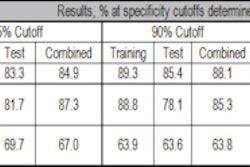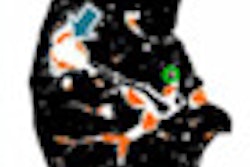Low-dose CT screening for lung cancer cuts lung cancer deaths by more than 20%, the U.S. National Cancer Institute (NCI) said today in its release of early results from the National Lung Screening Trial (NLST).
The trial, launched eight years ago, followed more than 53,000 current and former smokers who were randomized to either x-ray or low-dose CT lung screening. The early results represent a clear confirmation of screening's benefits, after more than a decade of screening trials have strongly suggested but failed to prove in a randomized fashion a mortality benefit resulting from the screening of at-risk populations.
"This is the first time that we have seen clear evidence of a significant reduction in lung cancer mortality with a screening test in a randomized, controlled trial," said Christine Berg, MD, project officer for the lung screening study at NCI, in a statement providing the early results. "The fact that low-dose helical CT provides a decided benefit is a result that will have implications for the screening and management of lung cancer for many years to come."
"Now we have validation from the NCI that screening people at high risk for lung cancer with CT scans can significantly reduce mortality in lung cancer, which is causing more deaths each year than breast, prostate, colon, and pancreatic cancers combined,” said Laurie Fenton-Ambrose from the advocacy group Lung Cancer Alliance.
The NCI decided to release the findings after the trial's data and safety monitoring board notified the NCI director that the data "now provide a statistically convincing answer to the study's primary question and that the trial should therefore be stopped," according to the statement. Complete results and analysis will be compiled and published in a peer-reviewed journal within the next several months.
Beginning in 2002, the NLST enrolled 53,500 men and women at 33 trial sites throughout the U.S. To enroll, smokers and former smokers needed to have a smoking history of at least 30 pack-years and be without signs or symptoms of lung cancer. They were randomly assigned to undergo standard chest x-ray or low-dose helical CT.
The x-ray arm of the study was controversial from the start, inasmuch as the modality had already been shown to be relatively insensitive for detecting early lung cancers amenable to curative resection.
Participants were screened at the end of their first and second years in the trial, then followed for five years, during which all deaths were documented. As of October 20, 2010, 354 participants had died in the CT arm of the study, compared with 442 in the chest x-ray group.
The CT acquisition parameters were not explicitly defined; however, each scanner was tested individually with a phantom to ensure that diagnostic images could be produced at 40 mAs for the average-sized patient, according to an article describing the study design that was published online November 2, 2010, in Radiology.
Depending on the MDCT scanner model, the effective tube current-time product ranged from 20 to 30 mAs for an average-sized patient, the report stated, and the effective radiation dose was estimated at 1.5 mSv for the average-sized patient.
Following analysis of the data, the study's independent data safety and monitoring board concluded that the 20.3% reduction in lung cancer mortality "met the standard for statistical significance and recommended ending the study," according to the statement.
"This large and well-designed study used rigorous scientific methods to test ways to prevent death from lung cancer by screening patients at especially high risk," said NCI director Harold Varmus, MD, in a statement accompanying the results. "Lung cancer is the leading cause of cancer mortality in the U.S. and throughout the world, so a validated approach that can reduce lung cancer mortality by even 20% has the potential to spare very significant numbers of people from the ravages of this disease."
The researchers also found that all-cause mortality dropped by 7% in those screened with low-dose helical CT versus those randomized to chest x-ray. Lung cancer deaths constituted about 25% of all deaths in the trial, with others attributed to factors such as cardiovascular disease. Further analysis will be needed to understand these findings more fully, the NCI said.
Secondary end points of the trial that remain to be described fully include lung cancer stage at diagnosis, lung cancer survival, and adverse effects of diagnostic evaluation, according to the November 2 Radiology article. Data on quality of life and cost-effectiveness were also collected and will eventually allow the research team to answer the full range of questions about screening's effects.
The NCI statement also cited the "highly motivated and primarily urban" study cohort, and the use of major academic centers for screening as limitations of the study, as the U.S. population of smokers as a whole could be less motivated and have access to less comprehensive care. Radiation concerns from CT scanning will also need to be taken into account, according to the NCI; however, the robust mortality reduction appears to be a more important factor than radiation by orders of magnitude.
In another statement, James Mulshine, MD, associate provost and vice president for research at Rush University Medical Center in Chicago, said: "With this positive trial result, we have the opportunity to realize the greatest single reduction of cancer mortality in the history of the war on cancer."
"This is good news," Bruce Johnson of Boston's Dana-Farber Cancer Institute, which wasn't involved in the study, told USA Today. "The reduction in deaths is comparable to mammograms, which reduce deaths by 14% to 15%."
The results show the benefits of low-dose helical CT screening in an older, high-risk population, and suggest that if low-dose helical CT screening is implemented responsibly with careful follow-up, thousands of lives can be saved, said Denise Aberle, MD, NLST national principal investigator for ACRIN. "However, she added, "given the high association between lung cancer and cigarette smoking, the trial investigators re-emphasize that the single best way to prevent lung cancer deaths is to never start smoking, and if already smoking, to quit permanently."
By Eric Barnes
AuntMinnie.com staff writer
November 4, 2010
Related Reading
Lung group disputes CT screening study, April 29, 2010
Lung cancer screening often yields false positives, April 20, 2010
CT-screened lung cancer patients live longer, May 11, 2009
NELSON lung cancer trial yields positive early results, March 9, 2009
CT screening catches small cell lung cancers earlier, February 10, 2009
Copyright © 2010 AuntMinnie.com



















